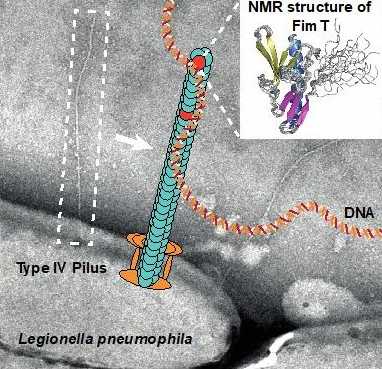FimT is a DNA-receptor important for bacterial natural transformation
A paper by the Hospenthal group (IMBB, ETH) in collaboration with the Gossert (BNSP, ETH) and Short (Monash University, Australia) groups, reveals FimT as a novel DNA receptor crucial for the uptake of DNA during bacterial natural transformation.

Horizontal gene transfer (HGT) is the movement of genetic information between bacterial cells. Natural transformation is a major avenue of HGT in bacteria, which is important for bacterial evolution and is a major driver of the rapid spread of antibiotic resistance and other pathogenicity traits in bacterial populations. This is one of the most serious medical challenges of today and, if left unchecked, will continue to lead to the emergence of ever more difficult to treat bacterial infections.
Naturally competent bacteria can take up free DNA present in their environment and integrate it into their genomes. In most competent Gram-negative bacterial species, DNA uptake across the outer membrane is mediated by the type IV pilus machinery. Type IV pili consist of thousands of pilus subunits assembled into hair-like structures at the cell surface that play a role in various functions, including natural transformation.
This study identified the pilus subunit FimT as a novel DNA receptor, which plays an important role in the natural transformation of the human pathogen Legionella pneumophila. Using a combination of NMR spectroscopy, DNA binding assays and in vivo functional assays, this study revealed the structure of FimT and its molecular basis in this process. Furthermore, a comprehensive bioinformatic analysis revealed that FimT is widely distributed amongst many bacterial species, which in combination with further DNA binding experiments, suggests that FimT likely plays a role in this process in many bacteria.
Link to the paper in external page Nature Communications